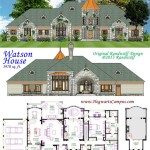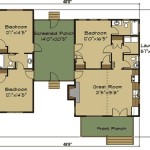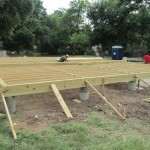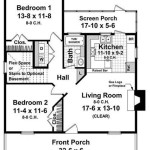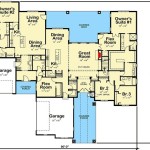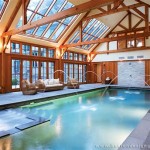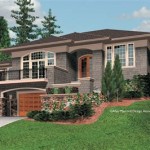Floor Plan for Small House: Maximizing Space and Functionality
Designing a small house floor plan presents unique challenges and opportunities. The focus is on maximizing every square foot, ensuring functionality, and creating a comfortable and livable space. Careful consideration of layout, storage solutions, and multi-functional design principles are crucial in achieving a successful small house design.
A well-designed small house floor plan should prioritize efficiency and flow. Minimizing wasted space, such as long hallways, is essential. Open-concept layouts are often favored, as they create a sense of spaciousness and allow natural light to permeate the entire living area. The selection of appropriate furniture and the strategic placement of each element play a significant role in achieving a harmonious and functional environment.
Understanding Space Limitations and Needs
The initial step in designing a small house floor plan involves a thorough assessment of the available space and the needs of the occupants. This includes accurately measuring the dimensions of the building envelope and identifying any existing structural elements, such as load-bearing walls or plumbing stacks, that might influence the layout. Furthermore, determining the number of occupants, their lifestyle, and their specific requirements are equally important.
For example, a single occupant may prioritize a spacious home office and a comfortable living area, while a family with children may require multiple bedrooms and a dedicated play area. Understanding these needs will allow designers to allocate space accordingly and make informed decisions regarding the placement of different rooms and functionalities. Prioritizing essential spaces and identifying areas where functions can overlap, such as a living room doubling as a guest bedroom, are key to efficient space utilization.
Another critical aspect of understanding space limitations involves taking into account building codes and zoning regulations. Setbacks, height restrictions, and minimum room sizes can significantly impact the design and layout of a small house. Consulting with local authorities or a qualified architect is crucial to ensure that the floor plan complies with all applicable regulations and avoids potential legal issues.
Implementing Space-Saving Strategies
Once the space limitations and needs have been assessed, the next step is to implement space-saving strategies throughout the floor plan. These strategies aim to maximize the usable area and create a sense of spaciousness, even within a limited footprint. Several techniques can be employed, including open-concept layouts, multi-functional furniture, vertical storage solutions, and strategic use of natural light.
Open-concept layouts combine the living room, dining area, and kitchen into a single, flowing space. This eliminates the need for interior walls, which can significantly reduce the overall square footage. By removing these barriers, natural light can penetrate deeper into the house, creating a brighter and more inviting atmosphere. Furthermore, open layouts encourage social interaction and make it easier to entertain guests.
Multi-functional furniture is another essential element in small house design. Items such as sofa beds, storage ottomans, and folding tables can serve multiple purposes, freeing up valuable floor space. Built-in storage, such as window seats with hidden compartments or bookshelves that double as room dividers, can also help to maximize storage capacity without adding extra bulk. Investing in high-quality, well-designed multi-functional furniture is a worthwhile investment for any small house.
Vertical storage solutions are particularly effective in maximizing space in areas with limited floor area, such as bathrooms and kitchens. Tall cabinets, shelving units that extend to the ceiling, and wall-mounted organizers can provide ample storage without encroaching on valuable floor space. Utilizing the vertical dimension not only increases storage capacity but also draws the eye upwards, creating a sense of height and spaciousness.
Strategic use of natural light can significantly impact the perceived size and ambiance of a small house. Large windows, skylights, and light wells can flood the interior with natural light, making it feel brighter and more open. Positioning windows strategically to capture sunlight throughout the day can also help to reduce energy consumption and create a more comfortable living environment. Light-colored walls and ceilings can further enhance the effect of natural light, reflecting it throughout the room.
Optimizing Room Layout and Functionality
Beyond space-saving strategies, optimizing the layout and functionality of individual rooms is essential for creating a livable and efficient small house. Each room should be carefully planned to maximize its usability and minimize wasted space. This involves considering the placement of furniture, the flow of traffic, and the specific activities that will take place in each room.
In the kitchen, for example, the work triangle – the relationship between the sink, refrigerator, and stove – should be carefully considered to ensure efficient workflow. Maximizing counter space and incorporating smart storage solutions, such as pull-out shelves and pantry organizers, can make food preparation and cooking more enjoyable. Small appliances can be stored in cabinets or on shelves to keep the countertops clear and uncluttered.
In the bathroom, space can be saved by using a corner sink, a wall-mounted toilet, or a shower stall instead of a bathtub. Vertical storage solutions, such as medicine cabinets and shelving units, can provide ample storage for toiletries and towels. Good lighting is essential to make the bathroom feel brighter and more inviting. Mirrors can also be used to create the illusion of more space.
Bedrooms in a small house should be designed to maximize comfort and relaxation. A minimalist approach is often preferred, with a focus on essential furniture items such as a bed, a bedside table, and a dresser. Built-in closets or wardrobes can provide ample storage for clothing and accessories. Light-colored walls and soft furnishings can create a calming and restful atmosphere. A small desk or workspace can be incorporated into the bedroom if necessary.
The living room should be designed to be a comfortable and inviting space for relaxation and entertainment. A sofa, a coffee table, and a television are essential furniture items. Multi-functional furniture, such as a sofa bed or a storage ottoman, can be used to maximize space. Good lighting is essential to create a welcoming atmosphere. A small bookcase or shelving unit can provide storage for books and accessories.
Hallways should be minimized or eliminated whenever possible. Open-concept layouts can often eliminate the need for hallways entirely. If hallways are unavoidable, they should be kept as narrow as possible. Utilizing the walls of hallways for storage, such as by installing shelving units or hooks, can help to maximize their functionality.
Outdoor spaces, such as patios, decks, and gardens, can significantly extend the living area of a small house. These spaces can be used for relaxation, entertaining, and outdoor dining. Careful planning is essential to ensure that the outdoor space complements the design of the house and provides a seamless transition between the interior and exterior. Vertical gardening can be used to maximize green space in areas with limited floor area.
Ultimately, a successful small house floor plan is one that is both functional and aesthetically pleasing. It should provide all the necessary amenities and living spaces while maximizing the use of available space. Careful planning, creative design solutions, and a focus on efficiency are essential to achieving this goal.

Small House Design 2024001 Pinoy Eplans Floor Plans

Small House Plan Examples

Best Floor Plan For A Small House Plans One Story

Small House Plans To Build Your Own Home

Small House Plans With S Houseplans Blog Com

Small House Plan Ideas For Diffe Area To See More Read It Floor Plans Kitchen

10 Small House Plans With Open Floor Blog Homeplans Com

Small House Design Series Shd 2024008 Pinoy Eplans

10 Small House Plans With Open Floor Blog Homeplans Com

Small Two Bedroom House

